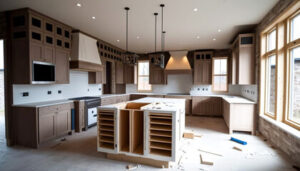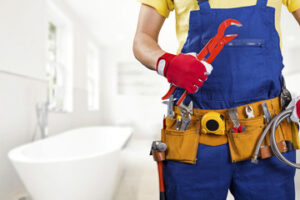Kitchen Remodel Near Me increases your home’s resale value and makes your living space more enjoyable. Choosing the right materials is key to keeping costs down and creating a durable, functional space.

Begin by setting a realistic budget and prioritize your needs and wants. For example, opting for simple woodwork over ornate crown molding and pilasters saves a bundle.
Cabinets are one of the most important features in any kitchen. They’re a focal point, and they come in a variety of colors, finishes, and sizes. A good kitchen design will include cabinets that suit the home’s style, meet its functional needs, and fit within a homeowner’s budget. There are three main types of cabinets: custom, semi-custom, and stock.
Custom cabinets are made to the homeowner’s specifications and feature higher quality construction (i.e., solid-wood drawer boxes with dovetail joinery and full-extension drawer glides). They are usually more expensive than semi-custom cabinets, but they can help ensure a perfect fit for the space and can be customized with any add-on features you may want.
Semi-custom cabinets offer more style options than stock cabinets and are a better value than custom cabinets. They can also be made to a narrower width (in 1/4-inch increments) than stock cabinets, which can save room. These cabinets are available in a variety of styles and can be customized with add-on features, such as rollout shelves or a pantry door.
Framed cabinets have doors and drawers attached to a box frame, which gives them more of a traditional look. They tend to work well in more formal homes and are often used with a wood countertop.
Slab kitchen cabinets, which have flat fronts and are essentially empty boxes, are a more minimalist option. They’re usually painted or stained to add visual interest and can be customized with unique hardware or other accents.
Floating cabinets are a simple way to open up the floor space in your kitchen and can be topped with an open shelf. They’re also a great choice for modern, industrial or Scandinavian designs.
Countertops
A new countertop can be a major part of your kitchen remodel. Appearance is a big consideration for many homeowners, but you should also think about the durability and maintenance requirements of your new work surface.
Natural stone is a classic choice for kitchen countertops, with granite being one of the most popular options. It is heavy and durable, and it can add value to your home. Granite comes in both solid slabs and tile, so you can find the right look for your budget. Marble is another beautiful natural material that is becoming increasingly popular. It is softer than granite, though, so it can be more susceptible to scratches and stains. Marble counters need to be sealed frequently.
If you want something that is easy to maintain and affordable, consider a laminate counter. It’s formed with a thin layer of plastic over particle board and is available in a variety of colors and patterns. Laminate is lightweight and easy to install, but it can be damaged by heat and may scratch or burn if not properly cared for. Some home buyers consider laminate counters to be less desirable than other materials.
If you’re looking for a more durable and trendy option, check out concrete counters. These can be poured on site and are available in a range of finishes, from honed to polished, to give your kitchen design a modern, minimalist feel. The best thing about these counters is that they have almost no seams, which can help keep bacteria at bay and the finish looking fresh and clean. You can even have them shaped and colored to fit your specific kitchen space.
Appliances
The appliances in your kitchen are a big part of the space’s aesthetic. That’s why it makes sense to select them early on in the remodel process. This is important because the appliances you choose can impact nearly every other aspect of the kitchen remodel – layout, plumbing, electrical and countertops cut outs. Appliances also take up a lot of visual real estate so making sure the finish and color of your appliances coordinate with the cabinets is critical.
Appliance trends come and go, but your kitchen’s major appliances should be timeless choices that will work well with your design style for years to come. Panel ready appliances are a good choice because they allow you to select a custom panel that matches the rest of your cabinetry for a cohesive look that will stand the test of time.
How your family uses the kitchen will influence what types of appliances you need. For example, if your family often eats out, it doesn’t make sense to invest in high-end cooktops and a double oven. Similarly, if you entertain guests often and host large dinners, you may want to upgrade to a larger refrigerator.
If your lifestyle is changing, a kitchen remodel provides an opportunity to upgrade your appliances and accommodate new cooking rituals. However, it’s a good idea to consult with your remodeling professional before selecting luxury appliances to ensure the final design of your kitchen meets your future needs. Also, be aware that highly customized features and appliances can limit your future home-buying audience. So, it’s a good idea to keep your kitchen remodel budget in mind. Taking some time to carefully pack up your belongings in well-labeled boxes can help make the transition during the remodel a little less stressful.
Flooring
Flooring is a huge component of kitchen design and can make or break the overall look of the space. During your kitchen remodel, you’ll want to choose flooring that will stand up to spills, heavy foot traffic, regular cleaning and dropped items (not to mention that it needs to be slip-resistant). Because of this, we recommend durable materials like tile and vinyl.
Vinyl has long been a staple of kitchen floors for its durability and affordable price tag. It comes in a variety of styles and patterns that mimic other materials, such as stone or hardwood floors. If you’re looking for a more sustainable option, bamboo floors are a great choice as they are made of a renewable resource. Bamboo flooring is also a softer material than tile or wood, making it more comfortable underfoot.
Solid hardwood floors are a traditional and classic choice that can be stained to match your new cabinetry. While not entirely water-resistant, if your wood floors are properly cared for they can last a long time and can be refinished to refresh their look as needed.
Another popular option is engineered wood, which has all the look of solid hardwood but is more resistant to moisture and warping. This is a great option for those who want the look of hardwood but don’t have a large budget to work with. Another alternative is luxury vinyl plank or luxury vinyl tile, which are plastic films that snap together to create the appearance of wood or stone. These products are extremely durable and can withstand the foot traffic of a busy family kitchen. If you’re looking for something even more environmentally friendly, consider cork flooring. It’s a soft and comfortable material that is made without the harsh chemicals used to make sheet vinyl.
Lighting
In the case of a kitchen remodel, lighting is an important element in bringing your vision to life. A new kitchen should be well-lit so you can cook safely and enjoy the results of your labor with friends and family. This requires layers of appropriate light types, including ambient, task, and accent.
The first step is to identify your objectives and determine the scope of your project. This may be as minimal as a cosmetic refresh or as extensive as tearing down walls and reconfiguring your layout. Your general contractor will help you decide on what is possible, and will be able to get you quotes from designers, architects, and engineers.
Next, the plumbing and electrical lines are installed to support your appliances and new fixtures. This step should be completed by licensed professionals, and is especially critical when it comes to rerouting or adding lines for gas or water, as this work can be very dangerous.
After the electrical and plumbing are in place, the walls can be closed up. This can be a messy job, but it’s essential for ensuring the integrity of your home and making sure everything is up to code.
Next, the electricians and plumbers install the new kitchen fixtures. This typically includes recessed and pendant lights, as well as under cabinet lighting. Recessed lighting can be used to illuminate a whole room, or it can be used to highlight specific areas like sinks and countertops where tasks are performed. Pendant lights can add a focal point over an island or dining area, and are also often used as accent lighting to highlight a beautiful backsplash or coffered ceiling.



